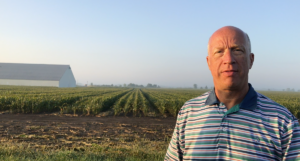We’re all a wee bit Irish come Sunday, even if your family tree has no roots in the Emerald Isle. And no holiday is more linked to a particular plant than St. Patrick’s Day is to the shamrock (which is actually a white clover). The relationship’s origins trace back 16 centuries ago, when the future Patron Saint of Ireland used a three-leaf shamrock to explain the mystery of the Holy Trinity. Along with the deep religious significance, clover plays an important role in agriculture. Often called “green manure”, due to its ability to remove nitrogen from the air and place it in the soil for future plant consumption, protein-dense clover has been a key component of hay and is commonly grown in pastures. Yet the recent surge in cover crops – currently grown on 18 million US acres and expected to double by decade’s end – revived this legume into a tool for row-crop farmers. It’s estimated that 39% of farmers who seed cover crops include clover in their mix. In addition to adding nitrogen to the soil, clover is an excellent soil health additive, prevents soil erosion and provides an excellent pollinator habitat.
Agriculture and transportation are deeply intertwined. As the late-great US Ag Secretary Earl Butz once told me, “Our natural resources of lakes and rivers, along with our investment in highways and rail, give US farmers a huge competitive advantage.” Any bottlenecks in moving ag products, or ag inputs, can have a serious economic impact throughout the supply chain. That’s why commodity groups devote so many resources to improving infrastructure. But in today’s global ag economy, transportation issues transcend beyond our borders. Such is the case with the Panama Canal, a prime gateway to Asian exports. A severe drought, prolonged by an El Nino, has dramatically lowered water levels of Gatun Lake that serves water to the canal. According to recent reports, less than 30 vessels per day are going through the canal and wait times have stretched to several weeks. This is causing significant delays and added costs. About 40% of North American container vessels pass through the canal annually, carrying grains and oilseeds (26 percent of soybeans and 17 percent of corn exports during 2022), as well as carrying both imports and exports of crop inputs such as fertilizers. Navigating around the tip of South America is not a desirable alternative. The delays are expected to continue through the spring.
House Ag Committee chairman GT Thompson offered the best update yet on the Farm Bill, telling a group of us last week that he expects a marked-up bill to emerge from committee by April 1. That’s certainly a step in the right direction for the legislation – projected to carry a price tag of $1.5 trillion. But during my visits to several congressional offices (representing both parties), I did not get a sense of optimism for passing legislation anytime soon. One key issue, which encouragingly appears to have bi-partisan support, is the preservation of crop insurance as a safety net. There is also rising hope that specialty crop producers could receive a greater slice of the FCI pie, albeit not the extent of commodity producers. Growers of almonds, pistachios and other nuts are having to tough go due to depressed prices.
“Define voluntary.” That was the question I posed to a House member’s chief of staff last week on the Hill. It drew a wry grin. I got the sense he knew where I was going, yet I elaborated. Could the Farm Bill be used as a mechanism for implementing policy mandates, disguised as voluntary, via crop insurance premiums? Federal crop insurance is a vital tool for farmers. It’s more than an insurance policy, it’s a must-have business strategy that protects against revenue shortfalls. More than 90% of commodity acres are insured with some form of FCI. We’re already seeing premium discounts for planting cover crops. Could this go further? For example, by implementing various production practices, could premiums be adjusted, based on a farmer’s compliance. Or putting it more bluntly, could growers be driven to farm a certain way? FCI premiums, albeit subsidized by the federal government, are still deemed expensive (especially at the higher levels of coverage). Could premiums rise sharply if there was a reluctance to cooperate with those recommended practices? Thus, leaving no choice but to “voluntarily” comply. His grin grew larger. He said that under the current leadership, any such incentives for specific practices would be used as discounts from the base premiums. However, he felt that if there was a change in leadership, all bets are off. Granted, he is politically motivated. But based on what we’re seeing in Europe, let’s hope the definition of voluntary remains pure.
Along those lines, the topic of growers cashing in on sustainably grown crops was discussed during a session I took part in last week with a key USDA official. I assessed that while CI opportunities are based on government tax credits to the biofuels industry, SBTi (strategic based target initiatives) are largely market driven. Food companies and retailers are setting their own requirements, based on market opportunities. I asked what role USDA may play moving forward, in relationship to such areas as labeling, incentivized tax credits and championing grower value. I did not hear a lot of specifics, just that USDA is very supportive of the movement and value must be created throughout the chain. He did say there are no plans to offer tax incentives for producing regen grown products. It sounds like, at least for now, it will continue to be driven by the private sector.
Related Posts

This Week in Ag #19
Rain makes grain. Those words are as old as farming itself. In the nation’s breadbasket – the three I states, which produce 42% of our corn and 37% of our soybeans – there’s concern over the lack of rain. That triggered a major movement in the grain market. Drought officially grips 100% of the I

This Week in Ag #2
Are we looking at a fertilizer shortage? Guess it depends on your definition. The availability of fertilizer isn’t a major concern in the US. It really wasn’t last year, either. As a good friend (who I consider to be among the best farmers in the country) told me last winter, “you can get it, it’s

This Week in Ag #28
The recent fertilizer market may be best described by two catch phrases: “wait-and-see” and “just in time.” In the fall of 2021, sky-rocketing energy prices pointed toward looming inflation and an inevitable rise in fertilizer prices. Many savvy growers, including those aligned with the regen ag movement, hedged their bets by purchasing crop nutrients that

